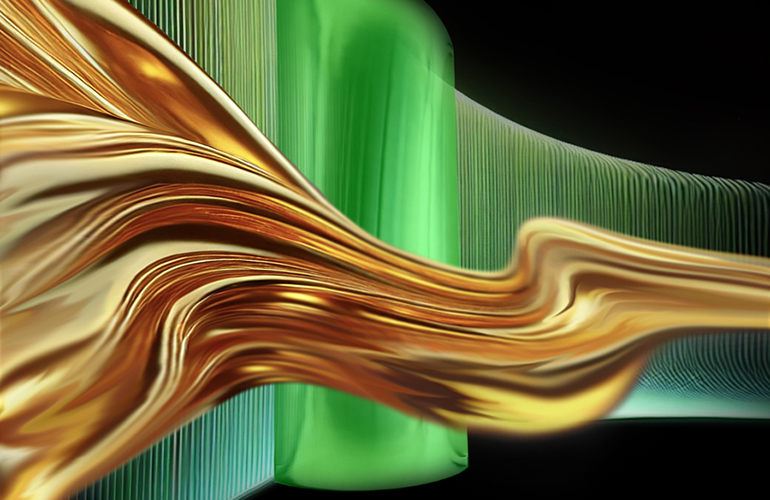Scientists at MIT have uncovered a discovery in quantum physics that may make the way toward practically infinite energy. They have successfully recreated the Quantum Hall Effect, an exotic quantum phenomenon using ultracold sodium atoms.

Also Read: NASA’s Hubble and Chandra Discover Supermassive Black Holes Duo
Electrons are highly unpredictable in their movement. They scatter in random directions, especially when they encounter obstacles. This scattering leads to friction and energy loss, which is why no electronic device is perfectly efficient.
When electrons flow through metals or other conductive materials, they behave much like birds in a sky or billiard balls on a table, colliding and bouncing off obstacles.
This chaotic behavior doesn’t occur in all materials. In some exotic substances, electrons can adopt a peculiar form of motion that differs from the norm, they travel along the boundaries of the material in an orderly fashion, bypassing obstacles altogether. This is called the edge state, a rare phenomenon that has fascinated physicists for decades.
The concept of the edge state is new. Its origins trace back to the discovery of the Quantum Hall effect in 1980, where scientists observed unusual electron behavior under specific conditions.
When materials were placed under extremely cold temperatures and strong magnetic fields, electrons didn’t flow through the material uniformly. Instead, they accumulated on one side in distinct quantum portions, defying traditional expectations of electron behavior.
To explain this, physicists proposed that edge states were responsible for carrying these currents. Under a magnetic field, the electrons were thought to be deflected toward the edges of the material, flowing in a precise and orderly pattern.
Observing electron edge states has been a task for physicists. These states occur over distances measured in nanometers and last for only femtoseconds, an unimaginably short time frame, equivalent to one-millionth of one-billionth of a second.
The MIT team, led by Richard Fletcher found a way to overcome this challenge. Instead of trying to observe electron edge states directly, which would require probing at the atomic and subatomic levels, they decided to replicate the same physics on a more manageable scale using ultracold atoms.
Quantum phenomena are difficult to study due to the incredibly small scales at which they occur. One key challenge is that events in the quantum world such as the quantum Hall effect take place over extremely short time intervals and within distances measured in fractions of a nanometer.
These minuscule parameters make it nearly impossible to capture the behavior of particles like electrons using traditional methods, even though understanding such phenomena is important for the development of next-generation technologies like superconductors.
The quantum Hall effect was first discovered in 1980 by German physicist Klaus von Klitzing. This effect describes the movement of electrons in two-dimensional materials, such as graphene, when subjected to extremely low temperatures and strong magnetic fields.
Under these conditions, instead of scattering and experiencing resistance, electrons form edge states, where they flow along the boundaries of the material without resistance.
These frictionless states of electron flow have implications for the development of materials that could operate without electrical resistance.
Also Read: SpaceX Launches Polaris Dawn Mission, First-Ever Private Spacewalk
Although the quantum Hall effect holds potential for technological applications, the conditions required to observe and study it, femtoseconds and nanometers are far too small and fast to capture using conventional scientific tools.
Richard Fletcher, an assistant professor at MIT highlights this challenge, stating, “These states occur over femtoseconds, and across fractions of a nanometer, which is incredibly difficult to capture.”
This difficulty has hindered the ability of scientists to fully understand or manipulate the quantum Hall effect, limiting the development of materials that could leverage its benefits.
To overcome this hurdle MIT scientists led by Fletcher and colleagues from the MIT-Harvard Center for Ultracold Atoms devised a new approach.
Instead of studying electrons directly, they recreated the quantum Hall effect using ultracold sodium atoms, which are much larger and slower than electrons.
This innovation allowed the researchers to study quantum phenomena at a more manageable scale, milliseconds instead of femtoseconds and microns instead of nanometers.
The team used a cloud of one million ultracold sodium atoms and trapped them using lasers. This experimental setup allowed them to mimic the behavior of electrons under quantum Hall conditions.
To simulate the experience of living in a flat, 2D space, the researchers spun the atoms like riders on an amusement park Gravitron. This created a balance between centrifugal force pulling the atoms outward and a trap pulling them inward.
The spinning environment also introduced the Coriolis effect, a force that deflects moving objects in a rotating system. This caused the massive sodium atoms to behave as if they were electrons moving in a magnetic field.
The researchers then used a laser to create a boundary or edge for the sodium atoms. Upon encountering this edge, the atoms flowed in one direction, similar to how electrons behave in the quantum Hall effect.
When the sodium atoms encountered the laser-defined edge, they show an intriguing property, they moved friction-free, following the boundary without scattering or losing energy.
Martin Zwierlein, a co-author of the study explained the phenomenon, “You can imagine these are like marbles that you’ve spun up really fast in a bowl, and they just keep going around and around the rim of the bowl. There is no friction. There is no slowing down, and no atoms leaking or scattering into the rest of the system.”
This behavior closely mirrored how electrons behave in edge states within materials under the quantum Hall effect, but with the advantage of being easier to observe due to the slower movement and larger size of the atoms.
To further test the resistance of these atoms the team introduced obstacles such as a point of light into their path.
Instead of bouncing off the obstacles or scattering, the atoms found their way around them without any measurable resistance, continuing their frictionless flow.
Fletcher compared the atoms’ behavior to magically navigating around the obstacles and returning to the edge.
Also Read: Elon Musk Says SpaceX will Start Launching Starships to Mars in 2026























